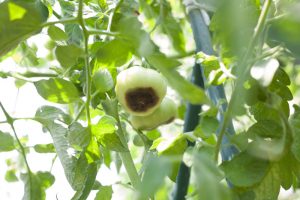Why Are My Tomatoes Turning Black? Understanding Blossom End Rot in Tomatoes
How to Treat Blossom End Rot
 One of the most common gardening questions we hear is, “Why are my tomatoes turning black?” This blackening, which typically appears on the bottom of the tomato, is called Blossom End Rot (BER). Although it can be alarming, Blossom End Rot is a physical issue, not a disease, and commonly affects tomatoes early in the growing season.
One of the most common gardening questions we hear is, “Why are my tomatoes turning black?” This blackening, which typically appears on the bottom of the tomato, is called Blossom End Rot (BER). Although it can be alarming, Blossom End Rot is a physical issue, not a disease, and commonly affects tomatoes early in the growing season.
What Causes Blossom End Rot in Tomatoes?
Blossom End Rot is the result of various environmental and care factors. It’s not limited to tomatoes; other plants like peppers, squash, melons, cucumbers, and eggplants can also be affected. Here are the leading causes:
- Water Stress: Inconsistent watering causes uneven soil moisture, leading plants to send available water to foliage first, which reduces calcium levels available to fruit.
- Calcium Deficiency: Low calcium levels in the soil limit the plant’s ability to supply fruits with necessary nutrients.
- Root Damage: Damaged roots hinder the plant’s ability to absorb water and nutrients effectively.
- High Nitrogen Levels: Excess nitrogen stimulates leaf growth over fruit production, increasing water and calcium demands.
- Soil Salinity: High salt levels in the soil reduce water absorption.
- Improper pH: Too low or too high soil pH disrupts nutrient uptake.
- Temperature Fluctuations: Cold soil and air temperatures can affect nutrient absorption early in the season.
How to Prevent and Control Blossom End Rot
While Blossom End Rot can be managed, preventive measures are the most effective. Follow these steps to promote healthier tomatoes:
- Add Calcium to the Soil: Mix calcium-rich amendments like lime or gypsum into the soil before planting. You can also top-dress with these if you notice Blossom End Rot later in the season.
- Maintain Consistent Moisture: Mulch around your tomato plants to retain moisture, and consider a watering schedule to keep the soil evenly moist.
- Avoid Excessive Nitrogen Fertilizers: High-nitrogen fertilizers encourage leafy growth at the expense of fruit health. Choose a balanced fertilizer with calcium and essential nutrients for tomatoes.
- Monitor Soil pH: Aim for a neutral pH (around 6.5 to 6.8) for optimal nutrient absorption.
- Wait for Warmer Temperatures: Plant tomatoes when the soil has warmed up to avoid early-season nutrient absorption issues.
Additional Tips for Container Gardening
For container-grown tomatoes, choose a potting mix with added calcium and use a large container to reduce watering frequency. Consider using a moisture-retaining product to keep soil consistently moist, as small containers tend to dry out more quickly.
Temporary Fixes
Blossom End Rot sprays and crushed Tums or Rolaids can provide a temporary calcium boost, but the best long-term solution is to address underlying issues.
Need Gardening Advice?
If you have any additional gardening questions, our experts are here to help. For personalized advice, reach out!